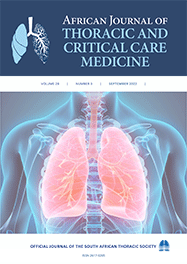Original research

Comparison of treatment outcome definitions in drug-resistant tuberculosis patients with high incidence of acquired second-line drug resistance
Abstract
Background. Simplified drug-resistant tuberculosis (DR-TB) treatment outcome definitions, mostly centred around receipt of treatment and sputum culture status at 6 months after treatment initiation, have been proposed, but have not been widely evaluated in resource-limited settings.
Objectives. To compare DR-TB treatment outcomes, as defined by the World Health Organization (WHO) at the time of treatment, with simplified definitions.
Methods. We performed retrospective folder reviews of a cohort of 246 South African DR-TB patients, most of whom developed secondline drug resistance. Sequential treatment outcomes were assigned retrospectively using both simplified Tuberculosis Network European Trials Group (TBNET)-based and 2013 WHO-based definitions.
Results. Of 246 patients, 40% were HIV-positive, and 88% developed second-line drug resistance. Patients were observed for a median of 38 (interquartile range 24 - 63) months from DR-TB treatment initiation. Using WHO-based definitions, 93% of patients had >1 sequential outcome, whereas with simplified definitions, 25% of patients had >1 outcome. Fewer outcomes of cure (3% v. 9%) and more outcomes of treatment failure (42% v. 22%) were assigned using simplified definitions.
Conclusion. Simplified outcome definitions applied to real-world patients with long, often complex treatment histories resulted in underestimating cures and overestimating treatment failures compared with WHO-based definitions. Simplified definitions may identify more individuals at higher risk for treatment failure than WHO-based definitions, but without consistent programmatic follow-up it may be difficult to distinguish cure, failure and loss to follow-up.
Authors' affiliations
K Anderson, Centre for Lung Infection and Immunity, Division of Pulmonology, Department of Medicine, and UCT Lung Institute, University of Cape Town, South Africa; Centre for Infectious Disease Epidemiology and Research, School of Public Health and Family Medicine, University of Cape Town, South Africa
E Pietersen, Centre for Lung Infection and Immunity, Division of Pulmonology, Department of Medicine, and UCT Lung Institute, University of Cape Town, South Africa
K Dheda, Centre for Lung Infection and Immunity, Division of Pulmonology, Department of Medicine, and UCT Lung Institute, University of Cape Town, South Africa; South African MRC Centre for the Study of Antimicrobial Resistance, University of Cape Town, South Africa; Faculty of Infectious and Tropical Diseases, Department of Infection Biology, London School of Hygiene and Tropical Medicine, UK
Y F van der Heijden, Vanderbilt Tuberculosis Center, Vanderbilt University School of Medicine, Nashville, USA; Division of Infectious Diseases, Department of Medicine, Vanderbilt University School of Medicine, Nashville, USA; The Aurum Institute, Johannesburg, South Africa
Full Text:
Cite this article
Article History
Date published: 2022-07-15
Article Views
Full text views: 140
Refbacks
- There are currently no refbacks.
African Journal of Thoracic and Critical Care Medicine| Online ISSN: 2617-0205
This journal is protected by a Creative Commons Attribution - NonCommercial Works License (CC BY-NC 4.0) | Read our privacy policy.
Our Journals: South African Medical Journal | African Journal of Health Professions Education | South African Journal of Bioethics and Law | South African Journal of Child Health | Southern African Journal of Critical Care | African Journal of Thoracic and Critical Care Medicine| South African Journal of Obstetrics and Gynaecology |



.jpg)